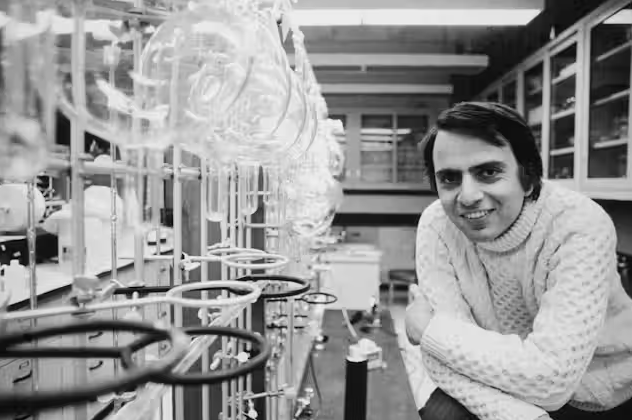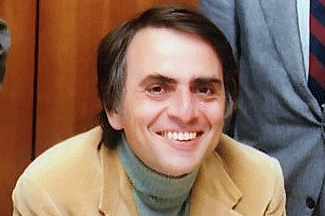Carl Sagan’s work transcended astronomy, captivating the public with his eloquent explanations of the universe and its mysteries. A prolific scientist, educator, and advocate for the search for extraterrestrial life, Sagan bridged the gap between the scientific community and the public. His ability to communicate complex ideas with clarity and wonder inspired a generation to look up at the stars and ask the big questions about humanity’s place in the cosmos.
Early Life and Education
Carl Edward Sagan was born on November 9, 1934, in Brooklyn, New York. His parents, Samuel and Rachel, fostered his curiosity by encouraging his love of books and science. As a child, Sagan was captivated by the stars and often visited the Hayden Planetarium, igniting a lifelong fascination with the universe.
Sagan attended the University of Chicago, where he earned degrees in physics and astronomy. His education was guided by some of the most prominent scientists of the era, including Gerard Kuiper, who introduced him to planetary science. Sagan’s doctoral thesis focused on the atmosphere of Venus, an area that would later become a cornerstone of his research.
Contributions to Astronomy
Sagan’s scientific contributions were as varied as they were groundbreaking. He played a key role in advancing our understanding of planetary atmospheres, including the greenhouse effect on Venus and the seasonal changes on Mars. His early work on the possibility of life on other planets influenced the development of astrobiology, a field he helped pioneer.
One of Sagan’s most enduring legacies is his role in the Voyager missions. He led the creation of the Golden Record, a message designed to communicate the diversity of life and culture on Earth to any extraterrestrial intelligence that might encounter the spacecraft. This gesture symbolized Sagan’s optimism and belief in the unifying power of science.
Sagan also contributed to the study of Jupiter’s atmosphere, Saturn’s moons, and the possibility of extraterrestrial life in the outer solar system. His interdisciplinary approach combined astronomy, chemistry, and biology, exemplifying the interconnectedness of the sciences.
Cosmos and Popular Science
Carl Sagan’s influence extended far beyond academia. In 1980, he wrote and hosted Cosmos: A Personal Voyage, a groundbreaking television series that brought the wonders of the universe to millions of viewers. Cosmos combined stunning visuals, cutting-edge science, and Sagan’s poetic narration to inspire awe and curiosity. It remains one of the most-watched science documentaries of all time.
Sagan’s bestselling book Cosmos, released alongside the series, became a global phenomenon, cementing his reputation as a master communicator. He authored more than 20 books, including The Demon-Haunted World, which championed critical thinking and the scientific method, and Pale Blue Dot, a profound meditation on humanity’s place in the universe.
Advocacy and Challenges
Sagan was a passionate advocate for science education and the peaceful exploration of space. He often spoke about the fragility of Earth and the importance of protecting it from nuclear war, climate change, and other existential threats. His concept of the “pale blue dot,” inspired by a photograph of Earth taken by Voyager 1, emphasized the need for unity and humility in the face of cosmic vastness.
Despite his accomplishments, Sagan faced challenges within the scientific community. Some colleagues criticized his popularization of science, arguing that it detracted from his academic work. Nevertheless, Sagan remained steadfast in his belief that science belonged to everyone, not just a privileged few.
Legacy
Carl Sagan’s legacy is profound. His scientific contributions, including his work on planetary atmospheres and the search for extraterrestrial life, laid the groundwork for modern planetary science and astrobiology. His efforts to communicate science inspired countless individuals to pursue careers in astronomy and related fields.
Figures like Subrahmanyan Chandrasekhar, who delved into the theoretical foundations of stellar evolution, and Vera Rubin, who uncovered the mysteries of dark matter, share Sagan’s passion for unraveling the universe’s secrets. But it was Sagan’s unique ability to make science accessible and relatable that set him apart, echoing the work of Galileo Galilei, who also sought to make the cosmos comprehensible to all.
In recognition of his contributions, the Carl Sagan Institute was established at Cornell University to continue the search for habitable planets and life beyond Earth. The phrase “billions and billions,” often associated with Sagan, has become a cultural touchstone, reflecting his awe at the vastness of the cosmos.
Scoring Section
• Contribution to Astronomy: 35/50
For advancing planetary science, astrobiology, and the search for extraterrestrial life, as well as his role in the Voyager missions.
• Advancement of the Field: 30/30
For inspiring a generation to value science and supporting the growth of astrobiology and planetary exploration.
• Recognition and Honors: 14/20
While Sagan was widely celebrated by the public, some in the academic community undervalued his contributions due to his focus on popularizing science.
• Historical Significance: 10/10
As one of the most influential science communicators of all time, Sagan’s impact on both astronomy and public understanding of science is unparalleled.
Total Score: 89/100






